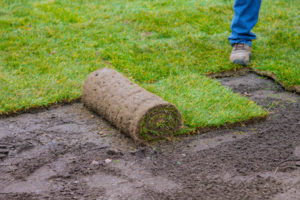
Laying sod in winter might sound impossible, but it’s not. You just need to know some tips on how to manage new sod in winter.
When it comes to laying sod, most people are going to choose to lay it during the warmer months, especially spring and summer. There’s nothing wrong with this, and these seasons are good for laying sod for many reasons. However, laying sod can be done in the winter. In some cases, it might even be beneficial to choose to lay your sod during the colder winter months. Warm-season grasses and cool-season grasses go dormant at different temperatures, so it’s important to take note of what type of grass you’ve chosen and what your average daily temperature is in order to determine what the best method of care is once your sod has been installed.
Warm-Season Grasses
Here in Maryland and other areas that experience cold winters, laying warm-season grass sod, such as Zoysia and Bermuda grasses, is the more difficult process due to the fact that the grass will be dormant. In fact, you may even find it difficult to locate warm-season grass sod locally because of this. However, it is not impossible to lay warm-season grass sod during the winter months, even in a colder climate zone.
Something important to note is that warm-season grass sod won’t take root until spring, since it will be dormant when it arrives in the winter. This doesn’t mean you can just set it and forget it—these grasses will need a little extra TLC throughout the winter months to ensure they’re healthy enough to root when spring arrives. This means that the grass needs to be carefully watered throughout the winter season to help it green up quicker in the spring. Pay close attention to the weather and water the day before a frost. In addition, water a bit more heavily on very windy days—a dry wind can desiccate dormant sod that hasn’t had the chance to root properly. The grass should always be moist, but be careful not to overwater it. You should not be watering as heavily in the winter as you would in the spring or summer.
Cool-Season Grasses
For cool-season grass sod, many of the same rules apply. However, cool-season grasses don’t become dormant until temperatures consistently go below 45°F (approx. 7°C). In contrast, warm-season grasses become dormant once temperatures consistently go below 65°F (approx. 18°C). Since this is the case, you have more time during the winter months to lay cool-season grasses before they become dormant, especially if you live in an area with a fairly mild winter season. If you end up laying your sod once the grass has gone dormant, however, simply follow the same rules as outlined for dormant warm-season grasses.
Have More Questions? Stay in Touch!
Order early and order often to ensure the best service possible. Contact us through our online page. Please find us at 27616 Little Lane, Salisbury, Maryland 21801. Our phone number is 410-726-6103, and our fax number is 410-742-6550. Speak to Jason Anderson for Turf Grass Sales. Reach him by email at jason@quanticocreeksod.com. Finally, follow us on social media on Facebook, LinkedIn, and our blog!
